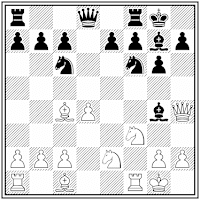Last week we looked at the Studier lines after 1.d4 Nf6 2.Nc3 d5 3.e4 dxe4 4.f3 exf3 5.Nf3 g6 6.Bc4 Bg7 7.00 00 8.Qe1 Nc6 9.Qh4 Ng4. We learned that white has at least an equal games, and is even better in the majority of lines.
However, instead of 9...Ng4, black can also play 9...Bf5 or 9...Bg4. This week we will look at black's strongest move, 9...Bg4.
Black attacks the pawn at d4 by removing a defender. What could white respond ?
- white could add an additional defender, by means of 10.Be3, 10.Ne2 or 10.Rd1
- remove the target by playing 10.d5
Playing 10.d5 does not look so good, black simply captures on f3 and exchanges a few pieces, eg 10...Bxf3 11.Rxf3 Ne5 and white faces a long uphill struggle for equality.
10.Rd1 is ridiculuous - white simply captures on f3 and white's position is a mess.
10.Be3 might look good, but white's move is purely defensive, leaving black with so many options... White can't even obtain equality in the simplest of lines, eg 10...Bxf3 11.Rxf3 ( diagram ) and now a killer move 11...e5 !! White is deprived of his attacking potential and faces a long struggle - not what he was hoping for.
10.Ne2 ( diagram ) is more complicated then 10.Be3, but black once again can seize the initiative, eg 10...Bf5. Redeploying the bishop seems silly, but leaves white with a nearly ubdefendeable position, eg 11.Bb3 Na5 and white's attack is halted before it is started.
So if I really have to choose, I would choose 10.Ne2 as chances are small that black will know the killer move 10.Bf5.
But maybe, maybe.... I might have to consider an alternative to the Studier Attack...



Interesting you should note 10.Ne2 Bf5! Earlier this week I came to the same conclusion. I have always played 10.Be3. I know the theory is a little questionable, but it pretty much takes a computer to play Black perfectly. I usually win vs humans here. It is a pet line of mine from both sides. I have played it 240 times, slightly more from the White side than the Black. I enjoy your blog! Tim Sawyer
ReplyDelete